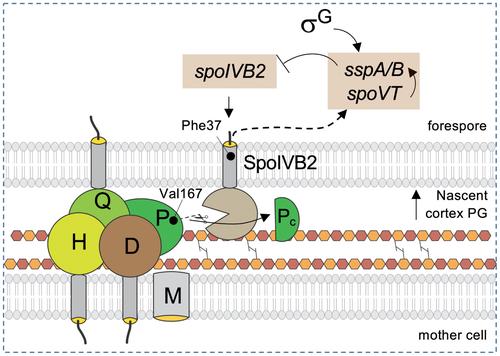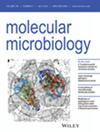Cleavage of an engulfment peptidoglycan hydrolase by a sporulation signature protease in Clostridioides difficile
IF 2.6
2区 生物学
Q3 BIOCHEMISTRY & MOLECULAR BIOLOGY
引用次数: 0
Abstract
In the model organism Bacillus subtilis, a signaling protease produced in the forespore, SpoIVB, is essential for the activation of the sigma factor σK, which is produced in the mother cell as an inactive pro-protein, pro-σK. SpoIVB has a second function essential to sporulation, most likely during cortex synthesis. The cortex is composed of peptidoglycan (PG) and is essential for the spore's heat resistance and dormancy. Surprisingly, the genome of the intestinal pathogen Clostridioides difficile, in which σK is produced without a pro-sequence, encodes two SpoIVB paralogs, SpoIVB1 and SpoIVB2. Here, we show that spoIVB1 is dispensable for sporulation, while a spoIVB2 in-frame deletion mutant fails to produce heat-resistant spores. The spoIVB2 mutant enters sporulation, undergoes asymmetric division, and completes engulfment of the forespore by the mother cell but fails to synthesize the spore cortex. We show that SpoIIP, a PG hydrolase and part of the engulfasome, the machinery essential for engulfment, is cleaved by SpoIVB2 into an inactive form. Within the engulfasome, the SpoIIP amidase activity generates the substrates for the SpoIID lytic transglycosylase. Thus, following engulfment completion, the cleavage and inactivation of SpoIIP by SpoIVB2 curtails the engulfasome hydrolytic activity, at a time when synthesis of the spore cortex peptidoglycan begins. SpoIVB2 is also required for normal late gene expression in the forespore by a currently unknown mechanism. Together, these observations suggest a role for SpoIVB2 in coordinating late morphological and gene expression events between the forespore and the mother cell.

难辨梭状芽孢杆菌中的一种孢子标志蛋白酶对吞噬肽聚糖水解酶的破坏作用
在模式生物枯草芽孢杆菌(Bacillus subtilis)中,前孢子中产生的一种信号蛋白酶 SpoIVB 对激活σK 因子至关重要,而σK 因子在母细胞中是作为一种非活性原蛋白 pro-σK 产生的。SpoIVB 的第二个功能对孢子的形成至关重要,很可能是在皮层合成过程中。皮层由肽聚糖(PG)组成,对孢子的耐热性和休眠至关重要。令人惊讶的是,肠道病原体难辨梭状芽孢杆菌(Clostridioides difficile)的基因组编码了两个 SpoIVB 旁系基因,即 SpoIVB1 和 SpoIVB2。在这里,我们发现 spoIVB1 对于孢子的形成是不可或缺的,而 spoIVB2 框架内缺失突变体则不能产生耐热孢子。spoIVB2 突变体进入孢子形成过程,进行不对称分裂,并完成母细胞对前孢子的吞噬,但未能合成孢子皮层。我们发现,SpoIIP 是一种 PG水解酶,也是吞噬体(吞噬所必需的机器)的一部分,它被 SpoIVB2 裂解为非活性形式。在吞噬体中,SpoIIP 的酰胺酶活性为 SpoIID 裂解性转糖基酶提供底物。因此,在吞噬完成后,SpoIVB2 对 SpoIIP 的裂解和失活会抑制吞噬体的水解活性,而此时正是孢子皮层肽聚糖开始合成的时候。SpoIVB2 也是前孢子中正常晚期基因表达所必需的,其机制目前尚不清楚。这些观察结果表明,SpoIVB2 在协调前孢子与母细胞之间的后期形态和基因表达事件中发挥了作用。
本文章由计算机程序翻译,如有差异,请以英文原文为准。
求助全文
约1分钟内获得全文
求助全文
来源期刊

Molecular Microbiology
生物-生化与分子生物学
CiteScore
7.20
自引率
5.60%
发文量
132
审稿时长
1.7 months
期刊介绍:
Molecular Microbiology, the leading primary journal in the microbial sciences, publishes molecular studies of Bacteria, Archaea, eukaryotic microorganisms, and their viruses.
Research papers should lead to a deeper understanding of the molecular principles underlying basic physiological processes or mechanisms. Appropriate topics include gene expression and regulation, pathogenicity and virulence, physiology and metabolism, synthesis of macromolecules (proteins, nucleic acids, lipids, polysaccharides, etc), cell biology and subcellular organization, membrane biogenesis and function, traffic and transport, cell-cell communication and signalling pathways, evolution and gene transfer. Articles focused on host responses (cellular or immunological) to pathogens or on microbial ecology should be directed to our sister journals Cellular Microbiology and Environmental Microbiology, respectively.
 求助内容:
求助内容: 应助结果提醒方式:
应助结果提醒方式:


